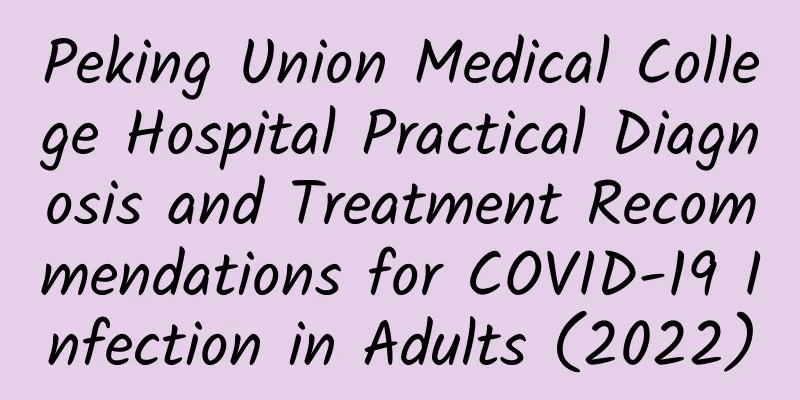Peking Union Medical College Hospital Practical Diagnosis and Treatment Recommendations for COVID-19 Infection in Adults (2022)

|
【Click to read】Practical diagnosis and treatment recommendations for novel coronavirus infection in adults from Peking Union Medical College Hospital (2022) Due to the urgent situation of epidemic prevention and control and the precious energy of frontline personnel, this diagnosis and treatment recommendation adheres to the principles of evidence-based, concise, and clinically feasible. The relevant opinions mainly refer to domestic and foreign guidelines, consensus, clinical databases, and large-scale clinical research evidence. For the differences between the recommendations of different guidelines, suggestions are given after multidisciplinary experts discuss; for key clinical issues that currently lack evidence-based medicine, certain recommendations are given in combination with the frontline clinical work experience and expert opinions of Peking Union Medical College Hospital. This diagnosis and treatment recommendation aims to enhance medical staff's understanding of new coronavirus infection and its critical illness, so as to promote clinical diagnosis and treatment standards and improve the level of patient treatment. 1 Basic knowledge of novel coronavirus infection 1.1 Diagnostic basis (1) Novel coronavirus infection There is a clear epidemiological history, clinical manifestations such as fever and/or respiratory symptoms, and the nucleic acid/antigen of the new coronavirus is positive. (2) Novel Coronavirus Pneumonia The patient was diagnosed with novel coronavirus infection, and new imaging abnormalities appeared in the lungs that were consistent with pneumonia caused by novel coronavirus infection. 1.2 Disease classification Taking into account oxygenation and breathing difficulties, risk factors for severe illness (immunosuppression, underlying diseases, and advanced age), the extent and progression of pneumonia, infected patients can be divided into mild, severe, and critical cases (Figure 1) [1-2]. Figure 1 Disease classification reference for adult patients infected with the new coronavirus 1.3 Recommended laboratory tests (1) Necessary inspection Vital signs, electrocardiogram, blood gas analysis (note to record oxygen inhalation conditions), blood routine, coagulation, D-dimer, liver/kidney function, lactate dehydrogenase, C-reactive protein (CRP). (2) Recommended examination Ferritin, erythrocyte sedimentation rate (ESR), procalcitonin (PCT), creatine kinase, high-sensitivity troponin, brain natriuretic peptide, T+ B lymphocyte subsets, interleukin-6 (IL-6), chest x-ray (if pneumonia is suspected). (3) Optional inspection Globulin, complement, and antiphospholipid antibody profiles; chest CT (for patients with critical condition and no imaging data within 72 hours). 1.4 Differential diagnosis of concurrent pneumonia Infection with the new coronavirus can cause pneumonia in some patients. Typical imaging findings are ground-glass opacities in the outer areas of both lungs, which may also be accompanied by consolidation, consistent with viral pneumonia. It needs to be differentiated from other diseases that can form ground-glass opacities, such as pneumonia caused by other viruses such as cytomegalovirus, as well as Pneumocystis jiroveci pneumonia, pulmonary edema, aspiration pneumonia, and acute interstitial pneumonia [3]. The absorption of pneumonia lesions may lag behind the improvement of clinical symptoms. 2 Treatment and management of patients infected with the new coronavirus 2.1 How to determine severe and critical illness? 2.1.1 High-risk factors for severe and critical illness Although people of all ages are at risk of contracting COVID-19 and developing severe illness, the following people are at higher risk of severe illness and require special attention: (1) Age ≥ 65 years [4]; (2) People living in nursing homes [5]; (3) Those who have not been vaccinated [6]; (4) Suffering from chronic diseases (cardiovascular disease, chronic kidney disease, chronic respiratory disease, diabetes, neurocognitive disorders, obesity, etc.) [7-9]; (5) People with various forms of immunosuppression , such as those undergoing tumor radiotherapy/chemotherapy, organ or hematopoietic stem cell transplantation, congenital immunodeficiency, human immunodeficiency virus (HIV) infection, and users of hormones/immunosuppressants/biological agents [10]; (6) Others: liver disease, pregnancy, heavy smokers, etc. 2.1.2 Warning signs for severe and critically ill patients Patients with severe pulmonary manifestations often develop into critical illness within the second week after symptom onset[11-12], so vigilance is required. The following situations should be considered as possible aggravation of the disease: (1) Worsening of hypoxemia or increased oxygen demand; (2) The symptoms of dyspnea worsen; inflammatory indicators (CRP, ferritin, ESR) or lactate increase significantly; (3) Increased levels of myocardial enzymes, liver enzymes, and creatinine; (4) Progressive decrease in lymphocyte count; (5) Rapid progress in lung imaging[13-14]. 2.1.3 Patient consultation and hospitalization criteria Patients who experience significant dyspnea, oxygen saturation ≤ 93% without oxygen, or other symptoms suggesting a serious illness are advised to see a physician [1,15]. Patients with one or more of the following characteristics are generally recommended to seek emergency medical evaluation as soon as possible: (1) Severe dyspnea (difficulty breathing at rest and inability to speak coherently); (2) When not receiving oxygen, oxygen saturation is ≤90%; (3) altered mental status (confusion, behavioral changes, difficulty in awakening); (4) Other manifestations of hypoperfusion or hypoxia (syncope, hypotension, cyanosis, oliguria, etc.); (5) Acute exacerbation of the underlying disease (acute coronary syndrome, acute exacerbation of chronic obstructive pulmonary disease, stroke, etc.). Currently, there is no unified standard for hospitalization. Patients with dyspnea can be considered for hospitalization. Patients who meet the emergency treatment conditions can also be hospitalized. The National Institutes of Health (NIH) guidelines recommend that patients who meet any of the criteria for severe patients in Figure 1 be hospitalized for diagnosis and treatment. In addition to the condition, the accessibility of resources must also be considered. If resources are sufficient, it is recommended to appropriately lower the threshold for hospitalization. 2.2 How are outpatients managed? Appropriate symptomatic treatment is recommended for outpatients; people at risk of developing severe or critical illness need to be identified and given antiviral treatment (Table 1). Patients discharged from the hospital with stable conditions after COVID-19 infection can also be followed up in the outpatient clinic. 2.2.1 Antiviral treatment for mild patients with pneumonia Some mild patients may also have pneumonia symptoms. If there are no other severe symptoms or risk factors, pneumonia symptoms do not necessarily indicate a poor prognosis. X-rays are effective in screening for pneumonia and are less harmful and more cost-effective. Patients with imaging manifestations of pneumonia but no other critical factors do not constitute an indication for hospitalization. For people without risk factors (such as previously healthy young people), close monitoring of oxygen saturation is recommended, but routine CT scans and the routine use of hormones are not recommended [16]. If monitoring of oxygen saturation and other indicators shows that the patient has become seriously ill, they should be treated as severe cases. Indications for considering antiviral therapy in patients: (1) Aged 65 years or older (regardless of risk factors and vaccine status, some guidelines recommend ≥ 60 years)[4] (2) Moderate to severe immunosuppression (regardless of vaccine status)[17] (3) Multiple risk factors for severe illness (regardless of age or vaccine status)[18] (4) Unvaccinated people over 50 years old (regardless of risk factors, especially those who have not received any vaccines and have no history of infection) Antiviral therapy is not recommended for the following patients: Under 65 years old, with normal immune function, previous health history, fully vaccinated, and no risk factors for critical illness. 2.3 How are hospitalized patients managed? 2.3.1 Medication management for inpatients Currently, the clinically available drugs for hospitalized patients mainly include hormones, antiviral drugs such as azithromycin, nematevir/ritonavir, and monoravir, and immunomodulatory drugs such as tocilizumab, baricitinib, and tofacitinib. The drug that is not currently available is remdesivir. The ninth edition of my country's diagnosis and treatment plan proposes that ambavir monoclonal antibody/romisvir monoclonal antibody injection can be used to treat adults and adolescents (12-17 years old, weight ≥ 40 kg) with high-risk factors for progression to severe illness; if conditions permit, COVID-19 human immunoglobulin and convalescent plasma can be used in the early stages of the disease to treat patients with high-risk factors, high viral loads, and rapid progression. It should be pointed out that studies have shown that antigen positivity and viral culture positivity are highly consistent, and nucleic acid positivity does not mean the presence of live virus[23]. If the disease course is late and the antigen is negative, the effect of antiviral drugs may not be good. Specific treatment recommendations are shown in Table 2 and Figure 2. Table 2 Treatment recommendations for hospitalized adults with COVID-19 infection[15] Figure 2 Flowchart of hospitalized treatment for adult patients infected with COVID-19 HFNC: high-flow nasal cannula oxygen therapy; NIV: non-invasive ventilation; ECMO: same as Table 2 (cited from uptodate.com/COVID-19: Management in hospitalized adults) 2.3.2 Treatment principles of oxygen therapy and mechanical ventilation Monitor oxygen saturation and administer oxygen therapy if necessary. It is recommended that patients maintain oxygen saturation between 92% and 96%[15]. Currently, there is no universally accepted method for determining whether a patient requires endotracheal intubation. Clinicians need to consider various factors. Common indications for intubation include poor airway protection, difficulty maintaining breathing, refractory hypoxemia, hypercapnia, encephalopathy, etc.[24-25] Emergency endotracheal intubation may cause respiratory arrest and increase the risk of infection for medical staff, so it should be avoided as much as possible [26]. Delayed intubation can lead to poor prognosis [27]. Some patients with hypoxemia may improve oxygenation and avoid endotracheal intubation by receiving high-flow nasal cannula oxygen inhalation [28]. Non-invasive positive pressure ventilation is not recommended for patients who have acute respiratory distress syndrome [29-30]. Prone positioning and awake prone positioning are clearly effective for patients with pneumonia caused by COVID-19 infection with respiratory failure [31-33]. For specific indications, practices, and goals, please refer to the relevant guidelines. 2.3.3 Precautions for hormone application It is recommended to comprehensively consider factors such as the patient's disease progression rate, degree of respiratory failure, imaging characteristics, and underlying diseases to determine the dosage form, dose, and usage of hormones, and increase or decrease the dose as appropriate when necessary. It is recommended that severe and critically ill patients who require oxygen or mechanical ventilation use dexamethasone 6 mg once a day [34]. Other hormones with equivalent doses can also be used, such as methylprednisolone 32 mg, prednisone 40 mg, or hydrocortisone 150 mg. Generally, it should not exceed 10 days [1,15]. If the course of treatment is more than 10 days, it is recommended to reduce the dose and then stop. When using baricitinib or tocilizumab, it needs to be used in combination with glucocorticoids [35-36]. 2.3.4 Precautions for the use of IL-6 antagonists Tocilizumab may be used in patients who: (1) Require high-flow oxygen therapy or stronger respiratory support; (2) After the addition of hormones, oxygen inhalation conditions still need to be upgraded and inflammatory indicators such as CRP are elevated [37]. It is usually used within 96 hours of hospitalization, or within 24 to 48 hours of ICU-level treatment[15]. It needs to be used in combination with hormones, usually as a single dose of 8 mg/kg. If necessary, the drug can be re-administered, but not more than twice[1]. 2.3.5 Precautions for the use of JAK inhibitors [15] The indications for JAK inhibitors are similar to those for IL-6 antagonists. Baricitinib is administered orally at a dose of 4 mg once a day for up to 14 days and can be used for severe and critically ill patients. If baricitinib is not available, tofacitinib can be used as an alternative, at a dose of 10 mg twice a day for up to 14 days[39]. There is no evidence that ruxolitinib (another JAK inhibitor) provides clinical benefit[40]. Baricitinib and tofacitinib have not yet been approved for the treatment of COVID-19 infection in my country. It is recommended that patients explain the necessity of the medication and sign an informed consent form for off-label use before taking the medication. 2.3.6 Timing of antibacterial treatment Patients with COVID-19 infection who visit a doctor for the first time rarely have concurrent bacterial infection[41]. COVID-19 itself can also cause prolonged fever, purulent nasal discharge, or yellow sputum. If the patient does not have leukocytosis, imaging findings of focal bacterial infection, or elevated PCT, antibacterial treatment is not necessary. Clinicians should be alert to the risk of nosocomial infection and perform bacterial and fungal pathogen tests in a timely manner. 2.3.7 Timing of anticoagulation therapy All hospitalized patients with COVID-19 infection should have platelet count, hemoglobin, prothrombin time, activated partial thromboplastin time, fibrinogen, and D-dimer tested. Unless contraindicated, all hospitalized patients with COVID-19 infection should receive thromboprophylaxis[15]. Low molecular weight heparin or unfractionated heparin[15] are the preferred agents. Patients without venous thromboembolism do not need routine thromboprophylaxis after discharge from hospital [42]. 2.3.8 Timing of convalescent plasma therapy Convalescent plasma is taken from the plasma of patients who have recovered from COVID-19 infection and can provide antibody-based passive immunity. Existing evidence has not found that convalescent plasma has a clear effect on critically ill patients, and it is not recommended to use convalescent plasma for patients on mechanical ventilation. Recent studies have shown that for most unvaccinated patients infected with the new coronavirus, administration of convalescent plasma within 9 days of symptom onset can reduce the risk of disease progression leading to hospitalization [43]. It is recommended that the decision on whether to use convalescent plasma be made based on the patient's disease course and drug availability. 2.3.9 Indications for ICU admission The following patients are recommended to be admitted to the ICU: (1) Require invasive mechanical ventilation and/or circulatory support; (2) Presence of shock; (3) Combined with multiple organ dysfunction; (4) Requires continuous bedside renal replacement therapy; (5) Extracorporeal membrane oxygenation (ECMO) support therapy is required[44]. It is recommended to fully consider the willingness of patients and their families to take invasive measures, as well as the accessibility of ICU resources. When patients show obvious signs of deterioration, they should consult with ICU doctors in advance and make plans. 2.3.10 Indications for discharge of inpatients The discharge indications for patients infected with the new coronavirus are similar to those for other hospitalized patients. Patients can be considered for discharge if they do not need to take antipyretics and their body temperature remains normal for more than 24 hours, their symptoms are significantly relieved, and their oxygenation is stable. 3Other issues related to COVID-19 infection 3.1 What is special about the treatment of COVID-19 infection during pregnancy? 3.1.1 Adequate oxygen support Generally, pregnant women require oxygen supplementation when their oxygen saturation is less than 95% to accommodate the physiological changes in oxygen demand during pregnancy and to ensure adequate oxygen supply to the fetus[45]. 3.1.2 Active targeted treatment Antiviral therapy may be considered, particularly for pregnant women who have not been vaccinated or who have comorbidities. Paxlovid[46], remdesivir, or monoclonal antibody therapy effective against prevalent variants[47] started as soon as possible after symptom onset are the treatment options of choice for pregnant patients. Molnupiravir may cause fetoplacental toxicity and is not a first choice[48]. If there is an indication for the use of hormones, it is recommended that they be used with the patient's full knowledge. 3.2 How should patients and medical staff protect themselves? If the positive patient can tolerate it, they should wear a surgical mask to control the spread of infectious droplets[49]. Clinicians should wear appropriate personal protective equipment and pay special attention when performing endotracheal intubation, extubation, bronchoscopy, suctioning, nebulization, high-flow oxygen inhalation, non-invasive ventilation, and manual assisted ventilation[50]. Even if they have been infected with the new coronavirus, clinical medical staff are advised to correctly choose and use protective equipment and pay close attention to hand hygiene at work based on whether they have come into contact with infected patients and the risk of infection. 3.3 How to understand the issues of re-positivity and reinfection? At the beginning of the epidemic, there were reports of patients testing positive for nucleic acid again after recovery from COVID-19 infection[51]. The duration of viral RNA in the body may vary depending on age and severity of the disease. For patients with normal immune function, improved clinical condition, and negative nucleic acid test results, the re-detection of viral RNA does not necessarily indicate active infection[52]. Generally, the re-detection of COVID-19 nucleic acid positive 90 days after the initial infection is called "re-infection", which means that the patient is infected again after fully recovering [53]. Studies have shown that although strain mutations may lead to immune escape, the initial infection can still provide considerable protection within 4 to 6 months. Compared with the initial infection, the proportion of people who are hospitalized, seriously ill or die after reinfection is significantly reduced [54]. Characteristics of reinfection when nucleic acid is positive include: new symptoms consistent with COVID-19 infection, a long interval from the previous infection, and high viral RNA levels (such as cycle threshold (Ct<33). It is generally believed that the next dose of vaccine can be omitted within 3 months after infection[55]. 3.4 How to interpret the Ct value of nucleic acid testing? The Ct value refers to the number of cycles required to amplify viral RNA to a detectable level during real-time polymerase chain reaction (RT-PCR) testing. Therefore, the Ct value can indicate the relative level of viral RNA in the sample, and the lower the Ct value, the higher the virus level. There is no standard treatment for patients who remain positive for RT-PCR 10 days or more after symptom resolution. However, such patients are generally less contagious, especially those with mild to moderate prior illness and who are not immunocompromised. Therefore, it is recommended that most patients be released from isolation using symptoms and time as criteria [56]. 4 Summary The challenges brought by the novel coronavirus infection will continue for quite a long time. Due to different severity, the infected group may receive diagnosis and treatment in different areas such as outpatient clinics, wards, and ICUs. This diagnosis and treatment recommendation combines the latest clinical evidence and sorts out and integrates the diagnosis and treatment recommendations in different scenarios (Figure 3), which will help to achieve full-process management from outpatient clinics to discharge, and hope to provide decision-making support for the current core task of the novel coronavirus diagnosis and treatment, which is "maintaining health and preventing severe illness". It is believed that this diagnosis and treatment recommendation can enhance the understanding of the majority of medical staff about novel coronavirus infection and its critical illness, and improve the level of patient treatment. Figure 3 Overall management process of COVID-19 infection in adults Corresponding author **Author Contribution: **This diagnosis and treatment recommendation was initiated and completed by the multidisciplinary collaboration group for the diagnosis and treatment of the new coronavirus in Peking Union Medical College Hospital. Zhang Shuyang led and organized the writing team and appointed Wang Mengzhao to be fully responsible for the writing of this recommendation by the writing team; Fan Junping, Liu Yongjian, Xu Yan, Tian Xinlun, and Wang Jinglan jointly drafted the first draft of the recommendation, and discussed and revised the recommendation under the organization of Zhang Shuyang and Wang Mengzhao to condense the recommendations; Du Bin, Fan Junping, Huang Hui, Han Jiangna, Li Taisheng, Long Yun, Liu Yongjian, Ma Xiaojun, Shi Juhong, Tian Xinlun, Wang Jinglan, Weng Li, Wang Luo, Wang Mengzhao, Xie Huaiya, Xu Yan, Xu Yingchun, Yang Yanli, Zhang Bo, Zhang Hong, Zhu Huadong, Zhao Jing, and Zhang Shuyang jointly participated in the second discussion and revision of this recommendation. Wang Mengzhao reviewed the full text and formed the final draft. Members of the writing group of this proposal (in alphabetical order) Du Bin (ICU, Department of Internal Medicine, Peking Union Medical College Hospital, Chinese Academy of Medical Sciences), Fan Junping (Department of Respiratory and Critical Care Medicine, Peking Union Medical College Hospital, Chinese Academy of Medical Sciences), Han Jiangna (Department of Respiratory and Critical Care Medicine, Peking Union Medical College Hospital, Chinese Academy of Medical Sciences), Huang Hui (Department of Respiratory and Critical Care Medicine, Peking Union Medical College Hospital, Chinese Academy of Medical Sciences), Li Taisheng (Department of Infectious Diseases, Peking Union Medical College Hospital, Chinese Academy of Medical Sciences), Liu Yongjian (Department of Respiratory and Critical Care Medicine, Peking Union Medical College Hospital, Chinese Academy of Medical Sciences), Long Yun (Department of Critical Care Medicine, Peking Union Medical College Hospital, Chinese Academy of Medical Sciences), Ma Xiaojun (Department of Infectious Diseases/Medical Affairs Office, Peking Union Medical College Hospital, Chinese Academy of Medical Sciences), Shi Juhong (Department of Respiratory and Critical Care Medicine, Peking Union Medical College Hospital, Chinese Academy of Medical Sciences), Tian Xinlun (Department of Respiratory and Critical Care Medicine, Peking Union Medical College Hospital, Chinese Academy of Medical Sciences), Wang Jinglan (Department of Respiratory and Critical Care Medicine, Peking Union Medical College Hospital, Chinese Academy of Medical Sciences), Weng Li (Department of Infectious Diseases, Peking Union Medical College Hospital, Chinese Academy of Medical Sciences), ICU, Department of Internal Medicine, Peking Union Medical College Hospital), Wang Luo (Department of Respiratory and Critical Care Medicine, Peking Union Medical College Hospital, Chinese Academy of Medical Sciences), Wang Mengzhao (Department of Respiratory and Critical Care Medicine, Peking Union Medical College Hospital, Chinese Academy of Medical Sciences), Xie Huaiya (Department of Internal Medicine, Peking Union Medical College Hospital, Chinese Academy of Medical Sciences), Xu Yan (Department of Respiratory and Critical Care Medicine, Peking Union Medical College Hospital, Chinese Academy of Medical Sciences), Xu Yingchun (Department of Laboratory Medicine, Peking Union Medical College Hospital, Chinese Academy of Medical Sciences), Yang Yanli (Department of Respiratory and Critical Care Medicine, Peking Union Medical College Hospital, Chinese Academy of Medical Sciences), Zhang Bo (Department of Pharmacy, Peking Union Medical College Hospital, Chinese Academy of Medical Sciences), Zhang Hong (Department of Respiratory and Critical Care Medicine, Peking Union Medical College Hospital, Chinese Academy of Medical Sciences), Zhao Jing (Department of Respiratory and Critical Care Medicine, Peking Union Medical College Hospital, Chinese Academy of Medical Sciences), Zhang Shuyang (Department of Cardiology/State Key Laboratory of Difficult, Severe and Rare Diseases, Peking Union Medical College Hospital, Chinese Academy of Medical Sciences), Zhu Huadong (Department of Emergency, Peking Union Medical College Hospital, Chinese Academy of Medical Sciences) Authors : Fan Junping, Liu Yongjian, Xu Yan, Tian Xinlun, Wang Jinglan References: *Omitted (see the link below) 【Click to read】Practical diagnosis and treatment recommendations for novel coronavirus infection in adults from Peking Union Medical College Hospital (2022) Editor: Liu Yang and Zhao Na Proofread by Li Na, Li Yule, and Dong Zhe Producer: Wu Wenming 【Copyright Statement】 "Pumch Medical Journal" advocates respecting and protecting intellectual property rights. Reprinting and quoting are welcome, but authorization from this platform is required. If you have any questions about the content and copyright of the article, please send an email to [email protected], and we will communicate with you in a timely manner. The graphic content is for communication and learning only, not for profit; the popular science content is only used to popularize public health knowledge. Readers should not use it as a basis for individual diagnosis and treatment, and do not dispose of it on their own to avoid delaying treatment. For medical treatment, please visit the Peking Union Medical College Hospital APP online or offline. |
>>: A must-read for fall and winter! 4 simple tips to relieve cold hands and feet
Recommend
How to fry eggs without turning them black or getting mushy Tips for frying eggs with good color
We all know that eggs are rich in nutrients such ...
What causes spots on the breast skin?
Women's breast health is a very important mat...
Why do girls squat to pee?
The uterus is particularly important for women. O...
Women's frequent urination medicine
I believe that many women have experienced varyin...
What kind of yoga is suitable for women over 40?
Yoga is a system that helps humans realize their ...
What is the difference between mousse cake and chiffon cake? What is the difference between mousse cake and cheesecake?
Cakes are quite common in the market. Everyone fr...
Reasons for premature menstruation
We all know that a woman’s menstrual period refle...
How long does it take for anemia medication to take effect in pregnant women?
If pregnant women do not take proper care of them...
Can’t drink water before a physical examination? This “physical examination notice” is not only useless, but also harmful!
As far as the current situation is concerned, fas...
Is it a good thing to have blood in the second month of pregnancy?
For vaginal bleeding at 14 weeks of pregnancy, a ...
What causes lower back pain and vaginal bleeding?
There are many women who always experience lower ...
What does Aircraft Traffic Control mean? How to choose the position of airplane windows?
When we are on a plane, we often hear that we hav...
Can I eat vermicelli during menstruation?
Rice noodle skin is a favorite choice of many peo...
Things to know about early pregnancy protection
Pregnancy preservation is a very important thing ...
What does pink menstrual period color mean?
Normally, women's menstruation is dark red. I...









